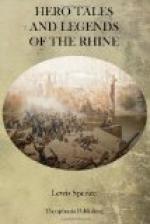Gunnar was now asked if he would purchase his life with the treasure, and he replied eventually that he would do so if he were given Hogni’s heart. To humour his request the Huns cut out the heart of a slave and brought it to him; but Gunnar saw through the stratagem and recognized the heart as that of a coward. They then cut out Hogni’s heart, and Gunnar, seeing that this was indeed the heart of a prince, was glad, for now he alone knew where the treasure of the Rhinegold was hid, and he vowed that Atli should never know of its whereabouts. In great wrath the Hunnish monarch ordered Gunnar to be thrown into a pit of snakes. His hands were bound, yet the hero from the Rhine played so exquisitely with his toes on a harp which Gudrun had sent to him that he lulled to sleep all the reptiles—with the exception of an adder, which stung him to the heart so that he died.
Atli, spurning the bodies of the fallen, turned to Gudrun, saying that she alone was to blame for what had happened. That evening she killed her two sons, Erp and Eitil, and served their flesh at the banquet which the King was giving for his warriors. When Atli asked for the boys to be brought to him, he was told that he had drunk their blood in his wine and had eaten their hearts.
That night, while he slept, Gudrun took Hogni’s son Hnifling, who desired to avenge his slaughtered father, and entering Atli’s chamber, the young man thrust a sword through the breast of the Hunnish king. He awoke through the pain of his wound, and was informed by Gudrun that she was his murderess. He bitterly reproached her, only to be told that she cared for no one but Sigurd. Atli’s last request was that his obsequies should be such as were fitting for a king, and to ensure that he had proper funeral rites Gudrun set fire to his castle and burnt his body together with those of his dead retainers.
The further adventures of Gudrun are related in certain songs in the Edda, but the Volsunga Saga proper ends with the death of Atli.
Comparisons between the Epics
We see from this account that the Volsunga Saga presents in many respects an older form of the Nibelungenlied story. Sigurd is the same as Siegfried; Gunnar, Hogni, and Gudrun are parallels with Gunther, Hagen, and Kriemhild—although, strangely enough, that name is also borne by Gudrun’s mother in the Volsunga Saga. We will recall that the events detailed in the first part of the lay of the Volsungs are vaguely alluded to in the Nibelungenlied, which assures us that the connexion we have thus drawn is a correct one.
Myth or History?




